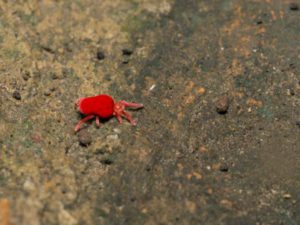CLOVER MITES ARE FREQUENTLY MISIDENTIFIED
By Zachary Ciras on May 17, 2021.
Because clover mites are very tiny, because they tend to “swarm” over surfaces in large numbers, and because the immature mites are reddish in color, people think the worst. To many, the mites’ red color implies that they suck blood (they don’t), so they are misidentified as chiggers, ticks, bed bugs, bird mites, and so on (see Indoor Chiggers Are Really Clover Mites).
YOU’LL NEED A MAGNIFYING GLASS
Admittedly, mites in general are very difficult to identify. To add to the confusion, the really bright red “velvet mites” found outside are often misidentified, even by experts, as clover mites. Although immature clover mites can be bright red, adult clover mites are more subdued in color, reddish-brown or greenish-brown with pale orange legs. The front pair of legs is longer and held forward. Of course, you’re not likely to see any of those eight gams without magnification. Clover mites are barely visible to the naked eye; the movement of a group of mites on a light-colored surface is usually the first indication.
Clover mites are plant pests, feeding mainly on grasses, clover and other weedy plants found in lawns. Heavy populations of clover mites can damage or kill grass around foundations. New homes or newly landscaped homes with lush, heavily fertilized lawns and grass planted right up to the house tend to have the biggest problems with clover mite indoor invasions.
SPRING INVASIONS OF CLOVER MITES ARE COMMON

Clover Mite.
Clover mites (Bryobia praetiosa) are outdoor mites that can end up on the outside, or even the inside, of houses by accident, usually when trying to escape a change in their outside environment. Clover mites are most active in cooler weather in spring and fall, and become dormant in hot weather when temperatures are above 80 degrees F. In fall, large numbers of red mite eggs that will hatch in spring may be seen on vegetation or on sunny foundation walls (see Clover Mites Can Invade Homes in Fall).
Clover mites may invade structures when grass dies in fall, but they are problems most often in early spring or late winter or during very cold, wet, or hot weather. They can gather by the thousands on sunny, exterior walls, seeking protection under shingles or siding. Their size lets them squeeze through window screens and crevices.
Once inside, clover mites usually die in a few days from dehydration. Clover mites do no damage and do not bite, but crushing them can leave a reddish spot on fabrics or surfaces. A vacuum with a soft brush attachment is your best bet for removing mites.
Mite problems lessen as lawns (and mite predators) become established. If clover mite invasions have been a problem around your house, you can reduce their numbers with lawn management, foundation clean-up, and professional treatment along the foundation and at entrance points.
MANAGING CLOVER MITES
- Mow your lawn short so it dries out during the day and reduce the amount of fertilizer used on the grass. Fertilize lawns in the fall, not spring.
- Prune back any shrubs that are touching the house and remove any ivy growing on exterior walls.
- Leave an 18-24 inch wide grass-free and shrub-free barrier strip along foundation walls to discourage migrating mites.
- Caulk window and door framing and weather-strip windows, especially on the sunny side of the house. But don’t be surprised if the tiny mites get through anyway.
- Contact Colonial Pest and ask about our semi-annual Preventative Maintenance Program. This twice-a-year inspection and treatment on the exterior of your home is timed to intercept invading clover mites and other seasonal invaders.